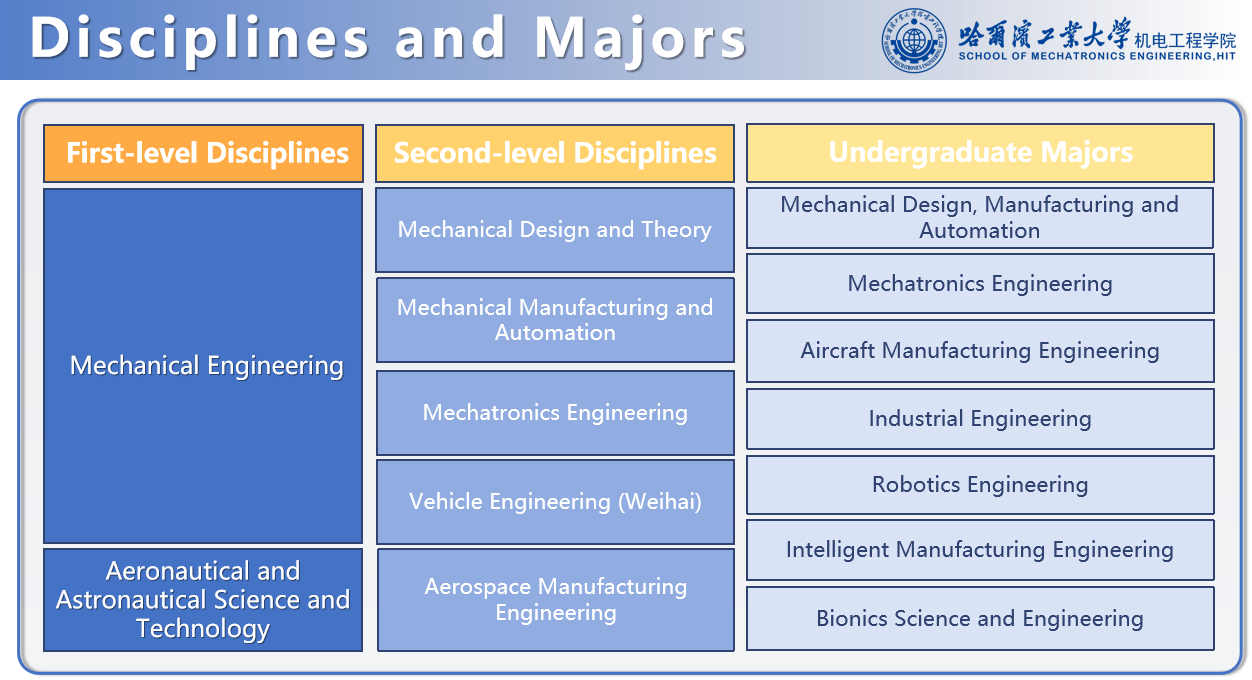
China's first arc welding and spot welding robots;
China's inaugural CNC ultra-precision machining machine tool;
The world's first lunar surface mobility system;
The first-ever human-robot collaborative in-orbit maintenance experiment;
The first active-passive composite suspension Mars rover to land on an extraterrestrial planet.
Over 10 academicians of the Chinese Academy of Engineering;
More than 100 national-level distinguished experts;
Over 200 alumni serving as chief commanders, chief designers, or lead designers in major aerospace and defense projects.
Mechanical Design, Manufacturing, and Automation;
Mechatronic Engineering;
Aircraft Manufacturing Engineering;
Industrial Engineering;
Robotics Engineering.
Mechanical Engineering;
Aerospace Science and Technology;
Mechanical Manufacturing and Automation;
Mechatronic Engineering.
Among the first in China to grant master's and doctoral degrees;
The inaugural postdoctoral research station;
The first primary discipline doctoral degree conferring unit.
3 Academicians of the Chinese Academy of Engineering;
102 recipients of national-level talent distinctions, including Academic Masters, Leading Scholars, and Top Young Talents;
2 National Teaching Excellence Award winners, 1 National Outstanding Educator, and 8 Provincial Teaching Excellence Award recipients;
14 national-level teaching and research teams, such as the NSFC Excellent Research Group and the Huang Danian-Style Teacher Team (awarded as a National Model Faculty Collective).
National Advanced Educational Unit;
National Outstanding Professional Talent Collective;
Chang'e-5 Lunar Mission Advanced Group;
China Youth May Fourth Medal Collective;
National Worker Pioneer Team.
Elite courses;
Award-winning faculty;
Cutting-edge academic resources.
Diversified knowledge systems;
Technological creativity;
Holistic competency;
8 national first-class courses;
11 provincial first-class courses;
14 MOOC courses;
15 nationally planned textbooks.
14 national-level teaching achievement awards;
60+ provincial-level teaching achievement awards.
National Mechanical Engineering Experimental Teaching Demonstration Center;
National Virtual Simulation Experimental Teaching Centerfor High-End Equipment Manufacturing;
China's Crewed Space Program and Lunar Exploration;
Deep Space Probes and On-Orbit Servicing Systems;
Inertial Confinement Fusion Initiatives.
CNY 2.7 billion (USD 380 million) in competitive research grants;
2 National Science and Technology Awards;
24 First-Class Provincial/Ministerial Science Prizes;
14 Second-Class Provincial/Ministerial Science Prizes.
State Key Laboratories;
National Advanced Manufacturing Innovation Centers;
International Collaborative Research Bases;
Industrial Digital Twins;
Precision Medical Robotics;
Sustainable Construction Technologies;
Agricultural Automation.
Developing internationalized teaching resources;
Expanding diverse overseas study programs;
Strengthening partnerships with leading global institutions.
Invited renowned experts from prestigious universities (e.g., MIT, ETH Zurich, KTH Royal Institute of Technology) to deliver short-term specialized courses, attracting over 50 international scholars annually for lectures and collaborative research.
Hosted four editions of the Intelligent Robotics International Summer School through the National Key Laboratory of Robotics and Systems, featuring lectures by faculty from Purdue University and KTH Royal Institute of Technology. This program has become a flagship initiative, attracting participants worldwide.
Short-term exchange programs for outstanding undergraduates;
Dual-degree undergraduate programs;
Integrated bachelor's-master's and master's-PhD pathways;
State-sponsored graduate exchange programs.
Massachusetts Institute of Technology (MIT);
University of California;
Purdue University;
University of Oxford;
University of Bath;
Equipment Design and Manufacturing Science and Technology Innovation Base;
Sino-German Space Robotics Joint Laboratory;
HIT-Brunel University Ultra-Precision Machining Overseas Collaboration Base.
General Institutional
The School of Mechatronics Engineering at Harbin Institute of Technology (HIT), established in 1993, traces its origins to the Department of Electric and Machinery founded in 1920. As one of HIT's oldest and most iconic schools, it embodies the university's spirit and tradition. Rooted in Northeast China, the school has dedicated itself to national service through decades of pioneering efforts, achieving numerous groundbreaking milestones in China and globally. Notable accomplishments include:
Guided by HIT's motto of'Rigor and Mastery'and its educational philosophy of'strengthen talent cultivation featuring a firm foundation, strong practice, strict process and innovation and cultivate outstanding innovative leading talent in the field of ecological conservation',the school has continuously reformed and advanced its disciplines, talent development, and scientific research. It has nurtured tens of thousands of industry leaders, including:
Aiming to build a world-class mechanical engineering discipline, the school has developed national strategic assets and cultivated globally recognized talents, achieving international leadership in frontier fields such as intelligent robotics, deep space exploration, and in-orbit servicing. These contributions have profoundly advanced China's mechanical engineering discipline and significantly bolstered the nation's aerospace and defense industries.
Disciplines and Programs
The school offers 7 undergraduate programs, including 5 National First-Class Specialty Development Programs:
It also hosts 2 national first-class disciplines at the first-level discipline category:
And 2 national key secondary disciplines:

HIT's Mechanical Engineering discipline, established in 1920, stands as one of China's earliest mechanical programs. It holds pioneering distinctions as:
Recognized as a National First-Class Key Discipline in 2007 and selected for China's inaugural Double First-Class Initiative in 2017, it has consistently ranked among the nation's top disciplines, securing 2nd place in the first national evaluation (2003) and an A+ rating in the fourth round (2017). After a century of development, the discipline now ranks 5th globally in Mechanical Engineering (2025 U.S. News) and 36th in the QS World University Rankings, underpinning HIT's Engineering discipline in reaching the top 0.1‰ globally (ESI ranking).
Faculty
The School of Mechatronics Engineering boasts a well-structured, academically vibrant, and highly qualified faculty, comprising:
Guided by its 'Eminent Scholars + Collaborative Teams' model, the school has earned prestigious accolades, including:
Additionally, faculty members have been honored with individual distinctions such as the National Innovation Pioneer Award, Ho Leung Ho Lee Prize, and China Youth Science and Technology Award, reflecting the school's dual excellence in collective impact and individual brilliance.
Talent Cultivation
The school exemplifies HIT's talent cultivation ethos of 'Solid Foundation, Rigorous Practice, Strict Processes, and Innovation-Driven', aiming to nurture visionary leaders in mechanical engineering and related fields. These individuals are characterized by unwavering ideals, ethical integrity, interdisciplinary expertise, global vision, and profound national commitment. Leveraging its teaching and research platforms, the school has established a comprehensive talent development system integrating:
Through strategic planning and interdisciplinary synergy, the school pioneered the '3D-4O-5C Multi-Level Integrated Cultivation Model'(Three Dimensions, Four Orientations, Five Convergences), which emphasizes a progressive practical education framework spanning 'Teaching → Project Development → Competitions → Entrepreneurship'. This model synergizes research-driven pedagogy and innovation-led competitions to empower students with:
accelerating the implementation of personalized top-tier innovation training programs.
Academic Resources & Achievements
The school currently offers:
Since 2005, it has received:
Supported by 6 national teaching platforms, including the:
Providing world-class infrastructure for cultivating students' practical and innovative capabilities.
Scientific Research
The school aligns with national strategic priorities and global technological frontiers, addressing critical demands in economic development and public health. Leveraging its heritage in interdisciplinary research, it has established three signature research pillars:
1. Fundamentals of High-End Equipment and Component Design;
2. Intelligent Manufacturing and Ultra-Precision Machining;
3. Human-Machine-Environment Collaborative Robotics;
While spearheading emerging fields such as Bioinspired and Micro/Nano-System Technologies. This framework spans the full innovation chain from basic research breakthroughs to core technology development and large-scale engineering applications.
The school's mission-critical technologies, co-developed with industrial partners, have been instrumental in:
During the 14th Five-Year Plan Period (2021–2025), the school secured:
Research Infrastructure & Technology Transfer
The school operates 9 national research platforms, including:
complemented by 10 provincial/ministerial key laboratories and industry-academia hubs. These facilities underpin its globally recognized expertise in robotics, space mechanisms, medical devices, and nanoscale manufacturing.
By converging strengths in advanced equipment design, smart manufacturing, and autonomous systems, the school has established 4 cross-sector innovation centers targeting accelerating market-driven technology commercialization:
International Exchange
The School has pioneered reforms in global talent development by:
Curriculum Internationalization
Student Mobility Programs
The school collaborates with leading universities in Europe, North America, Australia, and Asia to offer programs including:
These initiatives employ joint training models such as '2+2', '3+1', and '4+1', providing students with personalized academic trajectories. Additionally, the school facilitates faculty exchanges with international universities to refine its global talent cultivation framework.
Global Research Partnerships
The school has established partnerships with institutions including:
and jointly operates platforms such as:
Academic Publishing Leadership
In March 2025, HIT launched the international journal SmartBot (ISSN: 2948-4432) in partnership with Wiley, focusing on cutting-edge domains like micro/nano robotics, soft robotics, and humanoid robotics. Supported by the State Key Laboratory of Robotics and Systems, the journal is part of China's Excellence Action Plan for STM Journals and aggregates global academic expertise.

